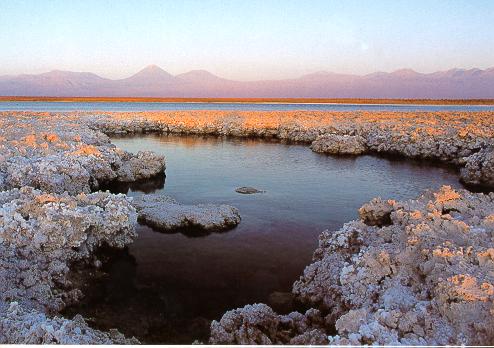
San Pedro de Atacama
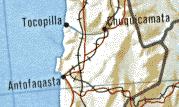
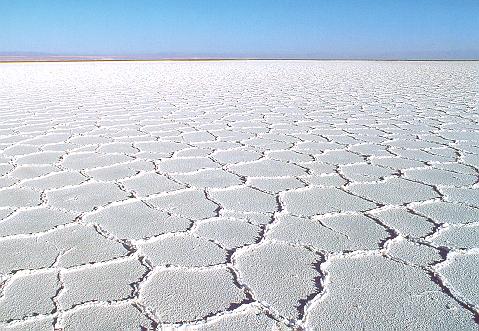 The harsh beauty of the Atacama is obviously the main attraction, but there are others. San Pedro has unique geological formations within biking distance, and is the starting point for longer excursions to the high plains with their unique wildlife, and the Tatio Geysers (a 2 hr drive north, near the "u" in Chuquicamata on the map). There are also the remains of a pre-Inca fortress and an Inca administrative center within hiking distance.
|
Cordillera de la Sal and Valle de la Luna(Salt Mountains and Valley of the Moon)The plain on which San Pedro sits is hemmed in by the Andes on the east and the Domeyko Mountains on the west. According to a local guide, at one point glaciers came down from the Andes and pushed a massive amount of salts up against the Domeykos. When the glacier melted, the piled-up salts stayed behind and formed what is now called the Salt Mountains. The view below is a close-up of a cave left by salt miners.
|
Pukara Quitor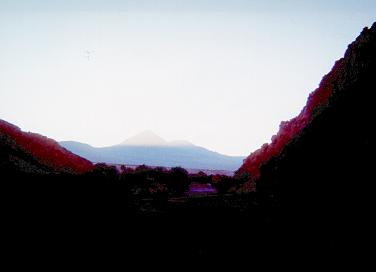 Pukara Quitor is a pre-Inca fortress 3 or 4 km northwest of town. Following the San Pedro River upstream north of town, the plain gives way to a canyon, and the fortress is dug in to the side of the canyon. In fact, what I saw looked less like a fortress than a bunch of natural holes in the very soft, crumbly rock, which had been enlarged and connected by human hands. But I may not have seen the whole thing: I was there very early and access to some parts might have been closed. You are supposed to get a great view of the whole valley from the top, but the parts I climbed on did not offer easy access to the top. I had a lot of fun climbing around, but watch out: it was very easy to climb up beyond the point where it was easy to climb down! This was made worse by the incredible crumbliness of the rock (or should I call it compacted sand?). I took the the above picture from the entrance looking back toward San Pedro. In the background, the first rays of the sun are hitting the volcano Licancabur. Just before reaching the fortress, there is a sign for the roughly 4-km trail to Catarpe, the Inca administrative center. Although I didn't have time to go, people I talked to had great fun hiking up there along a stream and finding it on top of a rock wall.
|
Toconao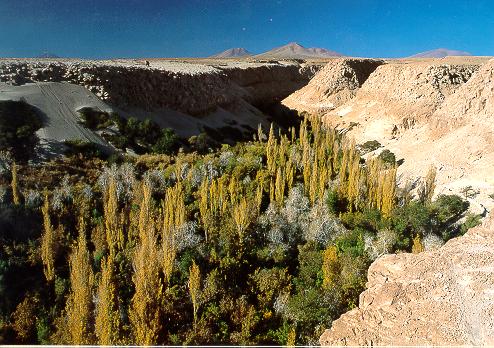
About 40 km south of San Pedro lies Toconao, a village even smaller than San Pedro. It seems to be absolutely in the middle of nowhere with no sustenance, but at its edge you come upon a river tumbling down from the Andes. The river has carved out a canyon (Quebrada de Jeria) which is green with life, making for an absolutely stunning contrast with the desert above. Unfortunately, I was on a tour with dozens of people, and although we walked down into the canyon, we weren't allowed much time to explore. Here is a perfect example of why you should avoid the organized tours. This would be perfect for hiking all day: the canyon and the river provide great relief from the heat (although that wasn't entirely necessary in July, it would be terribly useful most of the year), and it was said that there are old native petroglyphs within 5 miles. It's hard to know about hidden treasures like this in advance, but now you do. And perhaps there are other such canyons in the area. Toconao itself has a few shops which sell carvings from the local volcanic stone, some which have interesting themes. All the buildings are made of blocks of the same stone.
|
When to Go, Where to Stay, etc.Dust storms: A dust storm in the Atacama is not to be taken lightly. All excursions will be cancelled (if not, they're probably more worried about taking your money than showing you a good time), and I certainly didn't venture out of town, despite wanting badly to walk to Pukara Quitor and the Inca ruins. But there is one great thing to see during a dust storm: the museum. It's surprisingly full of cool artifacts for a museum in such a small village. It turns out that a longtime local priest was an archaeology buff and left a huge collection when he died. The nearest university took it over, organized it, and fortunately left it right in San Pedro. There is a great variety of well-preserved mummies and instruments for inhaling hallucinogens. You'll get a chance to practice your Spanish too, because there is little or nothing explained in English. Local wisdom has it that dust storms last three days, but luckily the one I was in lasted just one afternoon. That was just enough time to see the museum and do a few errands without getting bored. Where to stay: Hosteria San Pedro treated me so badly that I swore I would devote an entire web page to detailing their coldhearted misdeeds and lies (and I'm normally a very forgiving customer). (And it's not just me: I spoke to other guests who had their own nightmares, and I know several others like me that left early in disgust.) But I've had a few months to calm down, so this warning should suffice: Don't stay at Hosteria San Pedro! I moved to Hotel Terrentai when I could, and loved it. It has only about 12 rooms, so it's full much of the time. It's also more expensive, about US$110 per night. Those of you looking for cheaper, simpler lodgings should not be tempted to think that Hosteria San Pedro has a good combination of a not-too-high price with lots of amenities. You will be much better off with something very cheap and simple, which doesn't promise things it can't deliver. Note that the only places which offer heated rooms are Terrentai and a ridiculously expensive resort outside of town. I imagine that this becomes important only in July.
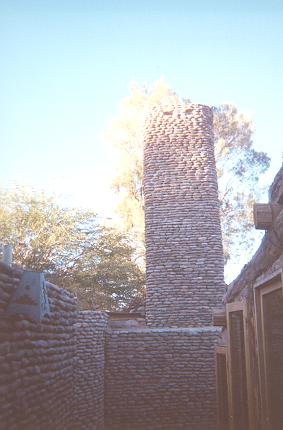 Where to eat: Todo Natural is almost literally a hole in the wall which you will see walking down the main street (variously called Caracoles or O'Higgins). It's just a homey kitchen with a counter around it, offering juices and empanadas and some other stuff I can't remember. When I ordered an empanada, the cook/waitress mixed the dough before my eyes. That's what I call homemade. And it was good. Because it's small, it can fill up with locals pretty easily. I also liked Casa Piedra (on Caracoles), which offered vegetarian specials and had a decent fixed-price menu for something like $2500 (less than USD$5). My least favorite was La Casona, which had terrible service until I changed tables to join some friends, and whose curried chicken had never been within a mile of any curry. I actually stopped in La Casona because they had live Andean music, but the musicians left before I sat down. I got the impression they made the rounds of all the restaurants, so don't choose on this basis. Expeditions: I took my tour of Valle de la Luna with Cosmo Andina. It's on Caracoles, on one corner of an intersection with three other travel agencies on the other three corners. I was very happy with that tour. For the salar, I went with a group organized by a different agency (whose name I forgot) and wasn't so happy: the guide basically spoke only when asked a question. I also got the impression that the tours run by Hotel Terrentai were first-rate and therefore cost a little more. How to stay in touch: I was very frustrated with CTC, which is the only phone company whose booth you see on your way through the airport when arriving in Santiago and transferring, so it's natural to buy a phone card there. But their cards work only in their phones because they have a device built in (whereas Entel's cards use a code you punch in after dialing an 800 number from any phone). I could not find a working CTC phone in San Pedro. Even the one in the CTC office had an Out of Order sign (and the CTC office was closed several times when their posted hours indicated they would be open). To be fair to CTC, they gave me my money back in Santiago. But I recommend using Entel: prices are the same and service is better. Their office in the Santiago airport is in a location impossible to explain to anyone who has not been there before, so just wait until you find an Entel office at your final destination. San Pedro has two internet cafes. I tried the one on Tocopilla, right next to Terrentai. It had good hot chocolate and lots of good books (in several languages) to browse while waiting for one of the two working computers to free up. Alas, I never got to test the Internet connection, but it's a cool place. I know people who had better luck first thing in the morning.
|
